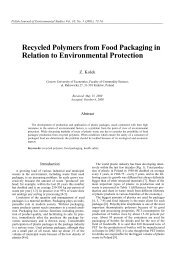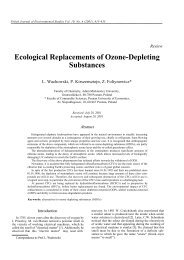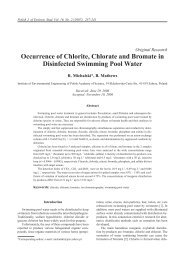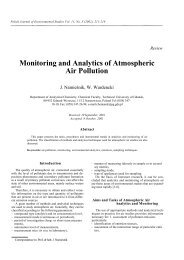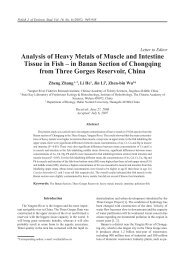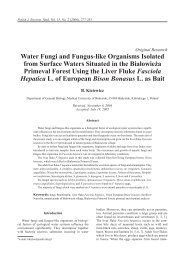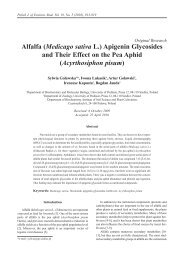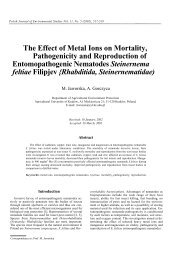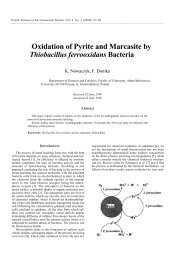Biological Effects of Mineral Nitrogen Fertilization on Soil ...
Biological Effects of Mineral Nitrogen Fertilization on Soil ...
Biological Effects of Mineral Nitrogen Fertilization on Soil ...
Create successful ePaper yourself
Turn your PDF publications into a flip-book with our unique Google optimized e-Paper software.
Polish Journal <str<strong>on</strong>g>of</str<strong>on</strong>g> Envir<strong>on</strong>mental Studies Vol. 11, No. 3 (2002), 193-198<br />
<str<strong>on</strong>g>Biological</str<strong>on</strong>g> <str<strong>on</strong>g>Effects</str<strong>on</strong>g> <str<strong>on</strong>g>of</str<strong>on</strong>g> <str<strong>on</strong>g>Mineral</str<strong>on</strong>g> <str<strong>on</strong>g>Nitrogen</str<strong>on</strong>g><br />
<str<strong>on</strong>g>Fertilizati<strong>on</strong></str<strong>on</strong>g> <strong>on</strong> <strong>Soil</strong> Microorganisms<br />
Review<br />
W. Barabasz 1 , D. Albińska 1 , M. Jaśkowska 2 , J. Lipiec 3<br />
1 Dept. <str<strong>on</strong>g>of</str<strong>on</strong>g> Microbiology Agricultural University, Cracow, Poland<br />
2 Pr<str<strong>on</strong>g>of</str<strong>on</strong>g>essi<strong>on</strong>al Medical College, Przemysl, Poland<br />
3 Dept. <str<strong>on</strong>g>of</str<strong>on</strong>g> Physics Agricultural University, Cracow, Poland<br />
Received: July 27, 2001<br />
Accepted: October 18, 2001<br />
Abstract<br />
The mineral fertilizati<strong>on</strong> <str<strong>on</strong>g>of</str<strong>on</strong>g> arable land positively affects an increase <str<strong>on</strong>g>of</str<strong>on</strong>g> the biological productivity <str<strong>on</strong>g>of</str<strong>on</strong>g><br />
various ecosystems as well as the microbial activity in soil. From the three elements N, P, K used for<br />
fertilizati<strong>on</strong> - nitrogen is <strong>on</strong>e <str<strong>on</strong>g>of</str<strong>on</strong>g> the most important factors affecting soil fertility and productivity as well as<br />
the growth and development <str<strong>on</strong>g>of</str<strong>on</strong>g> cultivated plants. The chemical studies show that high N rates <str<strong>on</strong>g>of</str<strong>on</strong>g> fertilizati<strong>on</strong><br />
result in the formati<strong>on</strong> <str<strong>on</strong>g>of</str<strong>on</strong>g> carcinogenic nitrosamines in soil envir<strong>on</strong>ments. The use <str<strong>on</strong>g>of</str<strong>on</strong>g> mineral N resulted in<br />
significant changes in microbiocenoses under investigated ecological c<strong>on</strong>diti<strong>on</strong>. The decline <str<strong>on</strong>g>of</str<strong>on</strong>g> some beneficial<br />
microorganisms, as well as the occurrence <str<strong>on</strong>g>of</str<strong>on</strong>g> carcinogenic nitrosamines in soil, were the symptoms <str<strong>on</strong>g>of</str<strong>on</strong>g><br />
changes in the envir<strong>on</strong>ment.<br />
Keywords: nitrogen fertilizati<strong>on</strong>, nitrosamines, microbial activity, soil agrocenoses<br />
<str<strong>on</strong>g>Fertilizati<strong>on</strong></str<strong>on</strong>g> in modern agriculture not <strong>on</strong>ly maintains,<br />
but even gradually increases field crop yield. Modern<br />
fertilizati<strong>on</strong> systems are not just an isolated element<br />
<str<strong>on</strong>g>of</str<strong>on</strong>g> plant producti<strong>on</strong>, but are indispensable link in the system<br />
<str<strong>on</strong>g>of</str<strong>on</strong>g> agrotechnical practice. Efficient fertilizati<strong>on</strong> provides<br />
plants with nutrients at appropriate proporti<strong>on</strong>s<br />
and quantities which enable maximum yield increase <str<strong>on</strong>g>of</str<strong>on</strong>g><br />
crops with high biological and technological quality. <str<strong>on</strong>g>Fertilizati<strong>on</strong></str<strong>on</strong>g><br />
should also gradually improve soil fertility. It<br />
should be menti<strong>on</strong>ed that soil fertility, decisive for proper<br />
development <str<strong>on</strong>g>of</str<strong>on</strong>g> cultivated plants and crop yield, depends<br />
<strong>on</strong> many factors, the most important being nutrient c<strong>on</strong>tents,<br />
and physical and chemical properties and metabolic<br />
activity <str<strong>on</strong>g>of</str<strong>on</strong>g> many microorganisms implicated in<br />
metabolic processes and energy flow [28]. The results <str<strong>on</strong>g>of</str<strong>on</strong>g><br />
studies c<strong>on</strong>ducted by Alexander [1], Myskow [25], Smyk<br />
[30]. Myskow et al. [26] and many other authors clearly<br />
indicate that microbiological and biochemical processes<br />
in soil envir<strong>on</strong>ment frequently prevail over purely chemical<br />
reacti<strong>on</strong>s. Although biomass <str<strong>on</strong>g>of</str<strong>on</strong>g> all microorganisms<br />
living in soil c<strong>on</strong>stitutes <strong>on</strong>ly several percent <str<strong>on</strong>g>of</str<strong>on</strong>g> organic<br />
matter c<strong>on</strong>tent, they play an important role in the functi<strong>on</strong>ing<br />
<str<strong>on</strong>g>of</str<strong>on</strong>g> entire ecosystems because, due to their enormous<br />
biochemical and biogeochemical activity, they can<br />
exert crucial effects <strong>on</strong> dynamics <str<strong>on</strong>g>of</str<strong>on</strong>g> multidirecti<strong>on</strong>al<br />
microbiological processes [5, 17,18, 31]. Microorganisms,<br />
being a part <str<strong>on</strong>g>of</str<strong>on</strong>g> all natural and man-made ecosystems,<br />
compose biocenoses which are significant and essential<br />
biochemical elements resp<strong>on</strong>sible for the entirety <str<strong>on</strong>g>of</str<strong>on</strong>g> biogenic<br />
element transformati<strong>on</strong> in soil envir<strong>on</strong>ment, and<br />
which exert critical effects <strong>on</strong> biochemical activity and<br />
ecological stability, and biological productivity <str<strong>on</strong>g>of</str<strong>on</strong>g> many<br />
field, forest and grassland ecosystems. They are involved<br />
in biochemical transformati<strong>on</strong>s <str<strong>on</strong>g>of</str<strong>on</strong>g> mineral fertilizers,<br />
Corresp<strong>on</strong>dence to: Pr<str<strong>on</strong>g>of</str<strong>on</strong>g>, dr hab. W. Barabasz
194<br />
particularly NPK fertilizers, synthesis <str<strong>on</strong>g>of</str<strong>on</strong>g> biologically active<br />
substances (amino acids, vitamins, antibiotics, toxins)<br />
and nitrogen fixati<strong>on</strong> from the air [19, 20]. They regulate<br />
element circulati<strong>on</strong> in soil envir<strong>on</strong>ment and make them<br />
assimilable for plants.<br />
Many years' studies and effects <str<strong>on</strong>g>of</str<strong>on</strong>g> agrotechnical practice<br />
clearly indicate that mineral fertilizati<strong>on</strong>, mainly nitrogen<br />
supply, has the str<strong>on</strong>gest influence <strong>on</strong> field crop<br />
yield. However, results <str<strong>on</strong>g>of</str<strong>on</strong>g> investigati<strong>on</strong>s carried out by<br />
Doran et al. [11], Smyk et al. [32], Jankins<strong>on</strong> [15],<br />
Barabasz [6], Barabsz and Smyk [9] and Gawr<strong>on</strong>ska [13]<br />
have shown that mineral fertilizati<strong>on</strong> also str<strong>on</strong>gly affects<br />
a number <str<strong>on</strong>g>of</str<strong>on</strong>g> microorganisms and qualitative selecti<strong>on</strong> <str<strong>on</strong>g>of</str<strong>on</strong>g><br />
whole communities <str<strong>on</strong>g>of</str<strong>on</strong>g> soil microorganisms. Although<br />
mineral fertilizati<strong>on</strong> has been shown to have beneficial<br />
effect <strong>on</strong> crop yield, incorrect agrotechnical measures<br />
and improper fertilizati<strong>on</strong> practice can lead to seriously<br />
disturbed functi<strong>on</strong>s <str<strong>on</strong>g>of</str<strong>on</strong>g> entire agroecosystems and c<strong>on</strong>tribute<br />
to the formati<strong>on</strong> <str<strong>on</strong>g>of</str<strong>on</strong>g> different compounds in soil (e.g.<br />
nitrosamines, mycotoxins) which are harmful for soil<br />
microorganisms and cultivated plants, and then for animals<br />
and humans [31, 32]. This detrimental phenomen<strong>on</strong>,<br />
a side-effect <str<strong>on</strong>g>of</str<strong>on</strong>g> the use <str<strong>on</strong>g>of</str<strong>on</strong>g> chemistry in agriculture,<br />
definitely influences activity <str<strong>on</strong>g>of</str<strong>on</strong>g> soil microorganisms, and<br />
c<strong>on</strong>sequently it indirectly affects fertility <str<strong>on</strong>g>of</str<strong>on</strong>g> arable soils.<br />
Study results <str<strong>on</strong>g>of</str<strong>on</strong>g> Doran et al. [11], Wqjcik-Wojtkowiak<br />
[35], Mallik and Tesfai [21], Mallik et al. [22] and Newbould<br />
[27] indicate that the above menti<strong>on</strong>ed agricultural<br />
chemicalizati<strong>on</strong>, especially caused by the use <str<strong>on</strong>g>of</str<strong>on</strong>g> high<br />
N fertilizer rates applied to arable, grassland and horticultural<br />
soils, might not <strong>on</strong>ly hazard biological productivity<br />
and ecological stability <str<strong>on</strong>g>of</str<strong>on</strong>g> agroecosystems, but can<br />
also threaten with polluti<strong>on</strong> <str<strong>on</strong>g>of</str<strong>on</strong>g> surface and underground<br />
waters by accumulati<strong>on</strong> <str<strong>on</strong>g>of</str<strong>on</strong>g> nitrates, nitrites and many<br />
other organic nitrogen compounds such as amines, nitro<br />
and nitroso compounds, including nitrosamines and nitrosamides.<br />
<str<strong>on</strong>g>Mineral</str<strong>on</strong>g> nitrogen, introduced into soil envir<strong>on</strong>ments,<br />
undergoes various biochemical transformati<strong>on</strong>s, in which<br />
many microorganisms and plants participate [7, 8]. Their<br />
dynamics depend <strong>on</strong> a number <str<strong>on</strong>g>of</str<strong>on</strong>g> ecological factors, but<br />
serious changes in soil nitrogen transformati<strong>on</strong>s can be<br />
expected under disadvantageous physicochemical c<strong>on</strong>diti<strong>on</strong>s<br />
in soil envir<strong>on</strong>ments, when nitrosamine precursors,<br />
such as primary and sec<strong>on</strong>dary amines, nitrates, nitrites,<br />
nitro and nitroso compounds are formed.<br />
Good N efficiency is particularly important for crop<br />
yield and envir<strong>on</strong>mental protecti<strong>on</strong> and should be discussed<br />
in relati<strong>on</strong> to the system comprising soil - water<br />
- plant. <str<strong>on</strong>g>Nitrogen</str<strong>on</strong>g> accumulated in soil, independently <str<strong>on</strong>g>of</str<strong>on</strong>g><br />
its origin, should be used for producti<strong>on</strong> <str<strong>on</strong>g>of</str<strong>on</strong>g> plant biomass<br />
and to maintain high soil fertility. However, under certain<br />
circumstances, nitrogen fertilizati<strong>on</strong> c<strong>on</strong>tributes to<br />
mobilizati<strong>on</strong> <str<strong>on</strong>g>of</str<strong>on</strong>g> soil nitrogen. Such a process occurs principally<br />
in soils to which a low rate <str<strong>on</strong>g>of</str<strong>on</strong>g> organic fertilizers<br />
was applied, with a low humus c<strong>on</strong>tent. In this event,<br />
decompositi<strong>on</strong> <str<strong>on</strong>g>of</str<strong>on</strong>g> organic matter in soils generates nitrates<br />
which, unless taken up by plants, can be leached by<br />
precipitati<strong>on</strong> to deeper soil layers and to ground waters.<br />
<str<strong>on</strong>g>Mineral</str<strong>on</strong>g> N fertilizers are applied to surface layers <str<strong>on</strong>g>of</str<strong>on</strong>g> soil<br />
while organic fertilizers are introduced to the depth <str<strong>on</strong>g>of</str<strong>on</strong>g><br />
10-20 cm below soil surface. Both these fertilizer types<br />
are the source <str<strong>on</strong>g>of</str<strong>on</strong>g> mineral N, which increases its c<strong>on</strong>cen-<br />
Barabasz W. et al.<br />
trati<strong>on</strong> in soil soluti<strong>on</strong> and saturates soil sorpti<strong>on</strong> complex<br />
with amm<strong>on</strong>ium i<strong>on</strong>s. An increase in the c<strong>on</strong>centrati<strong>on</strong><br />
<str<strong>on</strong>g>of</str<strong>on</strong>g> soil soluti<strong>on</strong> is accompanied by nitrogen leaching,<br />
if this element is not absorbed by plants. Hitherto c<strong>on</strong>ducted<br />
studies estimate that 15-50% fertilizers-derived<br />
N is leached to deeper soil layers and ground waters,<br />
which c<strong>on</strong>taminate surface waters c<strong>on</strong>tributing to facilitati<strong>on</strong><br />
<str<strong>on</strong>g>of</str<strong>on</strong>g> eutrophicati<strong>on</strong> (Table 1). Eutrophicati<strong>on</strong> leads<br />
to the accelerated phytoplankt<strong>on</strong> and waterside vegetati<strong>on</strong><br />
growth. Many phytoplankt<strong>on</strong> species, including cyanophyte,<br />
are harmful for humans and animals since they<br />
cause stomach diseases, catarrh or even palsy. In animals,<br />
serious pois<strong>on</strong>ing can lead to death due to nervous system<br />
paralysis.<br />
Table 1. <str<strong>on</strong>g>Nitrogen</str<strong>on</strong>g> leaching in relati<strong>on</strong> to the cultivated plants<br />
and N fertilizer rate (according to [23]).<br />
The most recent ecotoxicological studies have indicated<br />
that out <str<strong>on</strong>g>of</str<strong>on</strong>g> numerous chemical compounds c<strong>on</strong>taminating<br />
natural envir<strong>on</strong>ment (soil, water), nitrosamines<br />
deserve special attenti<strong>on</strong> as they are included<br />
am<strong>on</strong>g the most dangerous ecological pois<strong>on</strong>s for their<br />
detrimental biological and ecological effects [4, 24]. The<br />
studies <str<strong>on</strong>g>of</str<strong>on</strong>g> Alexander [2], Barabasz [6], Panchole [29] and<br />
Smyk et al. [31, 32] have dem<strong>on</strong>strated that nitrosamines<br />
endanger also all organisms inhabiting ecosystems and<br />
biological productivity <str<strong>on</strong>g>of</str<strong>on</strong>g> agroecosystems, grassland and<br />
forest ecosystems as surface water quality (rivers, lakes,<br />
p<strong>on</strong>ds), field crops, food products, and health <str<strong>on</strong>g>of</str<strong>on</strong>g> animals<br />
and humans. Moreover, Byrnes [10], Smyk [30] and other<br />
authors have reported that nitrosamines isolated from<br />
soil envir<strong>on</strong>ment <str<strong>on</strong>g>of</str<strong>on</strong>g> various ecosystems exerted str<strong>on</strong>g<br />
phytotoxic, mutagenic, teratogenic and carcinogenic effects<br />
<strong>on</strong> micro- and macroorganisms (plants, animals and<br />
humans). They are str<strong>on</strong>g inhibitors <str<strong>on</strong>g>of</str<strong>on</strong>g> DNA and RNA<br />
synthesis, block transmissi<strong>on</strong> <str<strong>on</strong>g>of</str<strong>on</strong>g> genetic informati<strong>on</strong> c<strong>on</strong>nected<br />
with amino acid synthesis and formati<strong>on</strong> <str<strong>on</strong>g>of</str<strong>on</strong>g> certain<br />
phytohorm<strong>on</strong>es, such as a-NAA resp<strong>on</strong>sible for rhizogenesis<br />
in higher plants.<br />
Ayanaba et al. [4], Focht and Verstraete [12], Hill [14]<br />
and Alexander [3] have shown that nitrosamine precursors<br />
are generated with the participati<strong>on</strong> <str<strong>on</strong>g>of</str<strong>on</strong>g> autotrophic<br />
(mainly <str<strong>on</strong>g>of</str<strong>on</strong>g> the genera Nitrobacter and Nitrosom<strong>on</strong>as) and<br />
heterotrophic microorganisms, engaged in nitrificati<strong>on</strong><br />
and denitryficati<strong>on</strong> processes, and numerous bacteria <str<strong>on</strong>g>of</str<strong>on</strong>g><br />
the genera Arthrobacter, Bacillus, Eubacterium,<br />
Pseudom<strong>on</strong>as, Mycobacterium, Nocardia and Streptomyces<br />
and soil fungi bel<strong>on</strong>ging to the genera Aspergillus,<br />
Candida, Fusarium, Cephalosporium, Penicillium and
<str<strong>on</strong>g>Biological</str<strong>on</strong>g> <str<strong>on</strong>g>Effects</str<strong>on</strong>g> <str<strong>on</strong>g>of</str<strong>on</strong>g> ...<br />
195<br />
Table 2. Average number <str<strong>on</strong>g>of</str<strong>on</strong>g> microorganisms in soil envir<strong>on</strong>ment <str<strong>on</strong>g>of</str<strong>on</strong>g> grassland ecosystems Arrhenatheretum elatioris and Gladiolo-Agrostidetum<br />
(the data presented as thousands/g <str<strong>on</strong>g>of</str<strong>on</strong>g> soil were obtained in the period 1975-1995)<br />
Table 3. Influence <str<strong>on</strong>g>of</str<strong>on</strong>g> many years' mineral NPK fertilizati<strong>on</strong> <strong>on</strong> the changes in number <str<strong>on</strong>g>of</str<strong>on</strong>g> species bel<strong>on</strong>ging to the selected groups <str<strong>on</strong>g>of</str<strong>on</strong>g><br />
microorganisms in soil envir<strong>on</strong>ment <str<strong>on</strong>g>of</str<strong>on</strong>g> grassland ecosystems Arrhenatheretum elatioris and Gladiolo-Agrostidetum (the data were obtained<br />
in the period 1975-1995)<br />
many others. Dynamics <str<strong>on</strong>g>of</str<strong>on</strong>g> nitrosoamine precursor generati<strong>on</strong><br />
and formati<strong>on</strong> <str<strong>on</strong>g>of</str<strong>on</strong>g> different nitrosamines in soil envir<strong>on</strong>ments<br />
depends <strong>on</strong> many ecological and physicochemical<br />
factors, characterizing soil envir<strong>on</strong>ment, such as pH<br />
and type <str<strong>on</strong>g>of</str<strong>on</strong>g> soil, vegetati<strong>on</strong> cover, amount and kind <str<strong>on</strong>g>of</str<strong>on</strong>g><br />
nitrogen substrate available for microorganisms, oxygen<br />
c<strong>on</strong>diti<strong>on</strong>s, precipitati<strong>on</strong>, agrotechnical measures, applied<br />
pesticides and N fertilizati<strong>on</strong> rate. Higher nitrosoamine<br />
c<strong>on</strong>centrati<strong>on</strong>s were observed in acid soils<br />
with low pH value ( pH 4.0-6.0) than in soils characterized<br />
by higher pH values (pH 5.0-7.5). In acid soils, nit-<br />
rosamines are readily produced, and various bacteria and<br />
fungi actively participate in this process. Ecotoxicological<br />
c<strong>on</strong>diti<strong>on</strong>s are worsened by the fact that, as indicated by<br />
Kaplan and Kaplan [16] and Tate and Alexander [33, 34],<br />
nitrosamines can be deposited in soil for 90-150 days, and<br />
their biodegradati<strong>on</strong> is very slow. In fact, some microorganisms<br />
can degrade nitrosamines to simple compounds<br />
in co-metabolic processes, and then use them as nutrients,<br />
however such bacteria are sparse, bel<strong>on</strong>ging principally<br />
to the genera Arthrobacter and Eubacter.<br />
An example <str<strong>on</strong>g>of</str<strong>on</strong>g> negative effect <str<strong>on</strong>g>of</str<strong>on</strong>g> high rates <str<strong>on</strong>g>of</str<strong>on</strong>g> NPK
196<br />
Barabasz W. et al.<br />
Table 4. Dominating species <str<strong>on</strong>g>of</str<strong>on</strong>g> microorganisms occurring in the studied envir<strong>on</strong>ments <str<strong>on</strong>g>of</str<strong>on</strong>g> grassland ecosystems Arrhenatheretum elatioris and<br />
Gladiolo-Agrostidetum in Jaworki, Pieniny Mountains (the data were obtained in the period 1975-1995).<br />
fertilizati<strong>on</strong> <strong>on</strong> permanent grassland is provided by the<br />
results <str<strong>on</strong>g>of</str<strong>on</strong>g> l<strong>on</strong>g term (1975-1995) comprehensive agrotechnical,<br />
chemical and microbiological studies <str<strong>on</strong>g>of</str<strong>on</strong>g><br />
m<strong>on</strong>tane soils <str<strong>on</strong>g>of</str<strong>on</strong>g> grassland ecosystems, Arrhenatheretum<br />
elatioris and Gladiolo-Agrostidetum floral communities in<br />
Pieniny Mountains at M<strong>on</strong>tane Experimental Stati<strong>on</strong><br />
IMUZ in Jaworki near Szczawnica. The data based <strong>on</strong><br />
field and laboratory investigati<strong>on</strong>s gathered for many<br />
years indicate that the applied fertilizati<strong>on</strong> exerted beneficial<br />
effect <strong>on</strong> an increase in soil microbiological activity<br />
and general raise in biological productivity <str<strong>on</strong>g>of</str<strong>on</strong>g> the grassland<br />
ecosystems, however, it led also to c<strong>on</strong>spicuous<br />
quantitative and qualitative changes in microbiocenotic<br />
compositi<strong>on</strong> <str<strong>on</strong>g>of</str<strong>on</strong>g> soil micr<str<strong>on</strong>g>of</str<strong>on</strong>g>lora and species compositi<strong>on</strong> <str<strong>on</strong>g>of</str<strong>on</strong>g><br />
meadow vegetati<strong>on</strong>. Although NPK fertilizati<strong>on</strong> caused<br />
an increase in green mass and hay yield by about 150-<br />
300%, hay feeding value was relatively low due to<br />
impoverished biodiversity.<br />
The data averaged over a 20-year period <str<strong>on</strong>g>of</str<strong>on</strong>g> quantitative<br />
studies presented in Table 2 indicate that high NPK<br />
fertilizati<strong>on</strong> rates significantly elevated the number <str<strong>on</strong>g>of</str<strong>on</strong>g><br />
microorganisms bel<strong>on</strong>ging to the studied groups. Number<br />
<str<strong>on</strong>g>of</str<strong>on</strong>g> bacteria, actinomycetes and fungi increased 2-, 2.5-and<br />
2-fold, respectively, in comparis<strong>on</strong> with c<strong>on</strong>trol.
<str<strong>on</strong>g>Biological</str<strong>on</strong>g> <str<strong>on</strong>g>Effects</str<strong>on</strong>g> <str<strong>on</strong>g>of</str<strong>on</strong>g> ... 197<br />
Table 5. Effect <str<strong>on</strong>g>of</str<strong>on</strong>g> many years' mineral NPK fertilizati<strong>on</strong> <strong>on</strong> nitrosamine c<strong>on</strong>tent in soil envir<strong>on</strong>ments <str<strong>on</strong>g>of</str<strong>on</strong>g> grassland ecosystems Arrhenatheretum<br />
elatioris and Gladiolo-Agrostidetum (the data were obtained in the period 1975-1995) (data in µg/ <str<strong>on</strong>g>of</str<strong>on</strong>g> soil)<br />
Table 3 shows that fertilizati<strong>on</strong> changed a number <str<strong>on</strong>g>of</str<strong>on</strong>g> species,<br />
members <str<strong>on</strong>g>of</str<strong>on</strong>g> the chosen groups <str<strong>on</strong>g>of</str<strong>on</strong>g> microorganisms.<br />
High N rates reduced number <str<strong>on</strong>g>of</str<strong>on</strong>g> bacteria and actinomycete<br />
species, but the change in the number <str<strong>on</strong>g>of</str<strong>on</strong>g> fungal<br />
species was negligible. It was dem<strong>on</strong>strated that high<br />
mineral N fertilizers rates evoked recessi<strong>on</strong> <str<strong>on</strong>g>of</str<strong>on</strong>g> bacteria <str<strong>on</strong>g>of</str<strong>on</strong>g><br />
the genera Arthrobacter and Sterptomyces by 50% <strong>on</strong> average<br />
and complete eradicati<strong>on</strong> <str<strong>on</strong>g>of</str<strong>on</strong>g> bacterial genera<br />
Azotobacter, Rhizobium and Bradyrhzobium. On the<br />
other hand, a rise in the number <str<strong>on</strong>g>of</str<strong>on</strong>g> microorganisms and<br />
biomass <str<strong>on</strong>g>of</str<strong>on</strong>g> the genera Eubacterium, Pseudom<strong>on</strong>as and<br />
Bac.ullus, and fungi <str<strong>on</strong>g>of</str<strong>on</strong>g> the genera Aspergillus, Fusarium,<br />
Penicillium, Verticillium and others was noted (Table 4).<br />
The observed changes in microbiocenotic compositi<strong>on</strong><br />
<str<strong>on</strong>g>of</str<strong>on</strong>g> m<strong>on</strong>tane soils <str<strong>on</strong>g>of</str<strong>on</strong>g> grassland ecosystems should be regarded<br />
as harmful from both biological and ecological<br />
points <str<strong>on</strong>g>of</str<strong>on</strong>g> view, since they create disturbances in nitrogen<br />
and carbohydrate metabolism in the study ecosystems,<br />
which can have negative c<strong>on</strong>sequences for their biological<br />
productivity.<br />
Chemical studies <str<strong>on</strong>g>of</str<strong>on</strong>g> soil <str<strong>on</strong>g>of</str<strong>on</strong>g> m<strong>on</strong>tane grassland ecosystems<br />
c<strong>on</strong>ducted over a many-year period have dem<strong>on</strong>strated<br />
that mineral N fertilizati<strong>on</strong> at rates exceeding 120<br />
kg N/ha/year is a direct cause <str<strong>on</strong>g>of</str<strong>on</strong>g> generati<strong>on</strong> <str<strong>on</strong>g>of</str<strong>on</strong>g> carcinogenic<br />
nitrosamines in soil. Table 5 presents nitrosoamine<br />
c<strong>on</strong>tents in the studied soils. The highest nitrosamine<br />
amounts were observed <strong>on</strong> plots fertilized at a rate <str<strong>on</strong>g>of</str<strong>on</strong>g> 360<br />
kg N/ha/year. Nitrosamine level exceeded even 25 µg/g <str<strong>on</strong>g>of</str<strong>on</strong>g><br />
soil. In should be emphasized that grasslands are overgrown<br />
with meadow vegetati<strong>on</strong>, and subject to <strong>on</strong>e-sided<br />
c<strong>on</strong>stant fertilizati<strong>on</strong> and always the same land use.<br />
Therefore, there are c<strong>on</strong>diti<strong>on</strong>s favoring nitrosamine accumulati<strong>on</strong><br />
in soil envir<strong>on</strong>ments. A completely different<br />
situati<strong>on</strong> occurs <strong>on</strong> cultivated fields, where crop rotati<strong>on</strong><br />
is applied, and agrotechnical measures, such as plowing,<br />
harrowing, sowing or fertilizati<strong>on</strong>, are changed, since<br />
they depend <strong>on</strong> the cultivated plant. Thus, <strong>on</strong> cultivated<br />
fields, favorable c<strong>on</strong>diti<strong>on</strong>s for nitrosamine accumulati<strong>on</strong><br />
do not develop, although at N rates <str<strong>on</strong>g>of</str<strong>on</strong>g> 180 kg N/ha/year,<br />
nitrosamine c<strong>on</strong>tents range 3-5 µg/g <str<strong>on</strong>g>of</str<strong>on</strong>g> soil.<br />
It should be emphasized that many years' mineral<br />
N fertilizati<strong>on</strong> <str<strong>on</strong>g>of</str<strong>on</strong>g> both grasslands and cultivated fields<br />
caused a c<strong>on</strong>siderable decrease in soil pH value, which<br />
dropped as low as pH 4.8-5.2.<br />
References<br />
1. ALEXANDER M. Ekologia mikroorganizmow. PWN, Warszawa<br />
1975.<br />
2. ALEXANDER M. Possible envir<strong>on</strong>mental c<strong>on</strong>sequences <str<strong>on</strong>g>of</str<strong>on</strong>g><br />
nitrosamines. [In] Nitrosamine Symposium, Uni<strong>on</strong> Carbige,<br />
15-21, 1977.<br />
3. ALEXANDER M. Biodegradati<strong>on</strong> <str<strong>on</strong>g>of</str<strong>on</strong>g> chemicals <str<strong>on</strong>g>of</str<strong>on</strong>g> envir<strong>on</strong><br />
mental c<strong>on</strong>cern. Science. 211, 132, 1981.<br />
4. AYANABA A., VERSTRAETE W., ALEXANDER M.<br />
Formati<strong>on</strong> <str<strong>on</strong>g>of</str<strong>on</strong>g> dimethyl<strong>on</strong>itrosamine, a carcinogen and<br />
mutagen in soil treated with nitrogen compooooounds. <strong>Soil</strong><br />
Sci.Soc.Am.Proc, 37(4), 565, 1973.<br />
5. BADURA L. Pojecie ekosystemu w ekologii mikroor<br />
ganizmow. Kosmos. 40 (2-3), 257, 1991.<br />
6. BARABASZ W., Rola mikr<str<strong>on</strong>g>of</str<strong>on</strong>g>lory w transformacji mineralnych<br />
zwiazkow azotu i w powstawaniu nitrozoamin w srodowiskach<br />
glebowych gorskich ekosystemow trawiastych.<br />
Zesz.Nauk. AR Krakow. Rozpr. Nr 119, 1987.<br />
7. BARABASZ W., Mikrobiologiczne przemiany azotu<br />
glebowego. I. Biogeochemia azotu glebowego. Post.Mikrobiol.<br />
30(4), 395, 1991.<br />
8. BARABASZ W., Mikrobiologiczne przemiany azotu<br />
glebowego. II. Biotransformacja azotu glebowego. Post.<br />
Mikrobiol. 31(1), 3, 1992.
198<br />
Barabasz W. et al.<br />
9. BARABASZ W., SMYK B., Mikr<str<strong>on</strong>g>of</str<strong>on</strong>g>lora gleb zmecz<strong>on</strong>ych.<br />
Zesz. Probl. Post. Nauk Roln. 452, 37, 1997.<br />
10. BYRNES B.H., Envir<strong>on</strong>mental effects <str<strong>on</strong>g>of</str<strong>on</strong>g> N fertilizer use<br />
- An overview. Fertilizer Research. 26, 209, 1990.<br />
11. DORAN J.W, SARRANTONIO M., LIEBIEG M.A., <strong>Soil</strong><br />
health and sustainability. Advance in Agr<strong>on</strong>omy. 56, 1,<br />
1996.<br />
12. FOCHT D.D, VERSTRAETE W., Biochemical ecology <str<strong>on</strong>g>of</str<strong>on</strong>g><br />
nitrificati<strong>on</strong> and denitrificati<strong>on</strong>. Adv. Microb. Ecology. 1,<br />
135, 1977.<br />
13. GAWRONSKA A., Zmianowanie roslin a zmeczenie gleb.<br />
Acta Acad. Agriclt. Tech. Olsst., Agricult., 64, 67, 1997.<br />
14. HILL M.J., Nitrosamines, toxicology and microbiology. Ellis<br />
Horwood Ltd. Chichester, England, 1989.<br />
15. JENKINSON D.S., The nitrogen cycle in l<strong>on</strong>g-term field ex<br />
periments. Phil.Trans.R.L<strong>on</strong>d<strong>on</strong> B. 269, 569, 1982.<br />
16. KAPLAN D.L., KAPLAN A.M., Biodegradati<strong>on</strong> <str<strong>on</strong>g>of</str<strong>on</strong>g> N-Nitrosodimethylamine<br />
in aqueous and soil systems. Appl. En<br />
vir<strong>on</strong>. Microbiol. 50(4) 1077, 1985.<br />
17. KASZUBIAK H., Liczebnosc, biomasa i produktywnosc<br />
drobnoustrojow w glebie. Kosmos. 123 A, 379, 1973.<br />
18. KASZUBIAK H., KACZMARKOWA W., Metody<br />
pomiarow liczebnosci i biomasy drobnoustrojow w glebie.<br />
Post. Mikrobiol., 13, 101, 1974.<br />
19. KENNEDY A.C, PAPPPENDICK J.R., Microbial charac<br />
teristic <str<strong>on</strong>g>of</str<strong>on</strong>g> soil quality. J.<strong>Soil</strong> and Water C<strong>on</strong>servati<strong>on</strong>. 50 (3),<br />
243, 1995.<br />
20. LYNCH J.M., POOLE N.J., Microbial Ecology: A c<strong>on</strong>cep<br />
tual approach. John Wiley & S<strong>on</strong>s. New York, Tor<strong>on</strong>to,<br />
1979.<br />
21. MALLIK M.A.B., TESFAI K., Transformati<strong>on</strong> <str<strong>on</strong>g>of</str<strong>on</strong>g> nit<br />
rosamines in soil and in vitro by microorganisms. Bull. En<br />
vir<strong>on</strong>. C<strong>on</strong>tain. Toxicol. 27, 115, 1981.<br />
22. MALLIK M.A.B., TESFAI K., PANCHOLY S.K, Forma<br />
ti<strong>on</strong> <str<strong>on</strong>g>of</str<strong>on</strong>g> carcinogenic nitrosamines in soil treated with pesti<br />
cides and in sewage amended with nitrogen compounds.<br />
Proc. Okla. Acad. Sci. 61, 31, 1981.<br />
23. MAZUR T., Azot w glebach uprawnych. PWN, Warszawa,<br />
1991.<br />
24. MILLS A.L., ALEXANDER M., Factors affecting dimethylnitrosamine<br />
formati<strong>on</strong> in samples <str<strong>on</strong>g>of</str<strong>on</strong>g> soil and water. J. En<br />
vir<strong>on</strong>. Quality. 5, 437, 1976.<br />
25. MYSKOW W., Proby wykorzystania wskaznikow aktywnosci<br />
mikrobiologicznej do oceny zyznosci gleby. Post. Mikrobiol.,<br />
20, 173, 1981.<br />
26. MYSKOW W, WROBLEWSKA B, STACHYRA A.,<br />
PERZYNSKI A., Wplyw wieloletniego nawozenia organicznego<br />
i mineralnego na biologiczne wiazanie azotu atmosferycznego<br />
oraz produktywnosc gleb lekkich. Pamietnik<br />
Putawski., 93, 131, 1988.<br />
27. NEWBOULD P., The use <str<strong>on</strong>g>of</str<strong>on</strong>g> nitrogen fertilizer in agricul<br />
ture. Where do we go practically and ecologically. Ecology <str<strong>on</strong>g>of</str<strong>on</strong>g><br />
Arable Land. Kluwer Academic Publisher. 281-295, 1989.<br />
28. ODUM E.P., Podstawy ekologii. PWRiL, Warszawa, 1982.<br />
29. PANCHOLY S.K., Formati<strong>on</strong> <str<strong>on</strong>g>of</str<strong>on</strong>g> carcinogenic nitrosamines<br />
in soil. <strong>Soil</strong> Biol. & Biochem. 10, 27, 1978.<br />
30. SMYK B., Biologiczne i biogeochemiczne skutki stosowanie<br />
mineralnych nawozow azotowych w rolnictwie. Zesz. Nauk.<br />
AR Krakow. 196 (10), 57, 1982.<br />
31. SMYK B, ROZYCKI E., BARABASZ W., Wplyw<br />
stosowanie mineralnych nawozow azotowych na<br />
wystepowanie nitrozoamin i mikotoksyn w Srodowiskach<br />
glebowych gorskich ekosystemow trawiastych. Zesz. Probl.<br />
Post. Nauk Rol., 337, 193, 1987.<br />
32. SMYK B., ROZYCKI E., BARABASZ W., Wplyw<br />
stosowania mineralnych nawozow azotowych (N i NPK) na<br />
wystepowanie nitroizoamin i mikotoksyn w glebach gorskich<br />
ekosystemow trawiastych. Zesz. Probl. Post. Nauk Roln.<br />
380,151, 1989.<br />
33. TATE A., ALEXANDER M., Stability <str<strong>on</strong>g>of</str<strong>on</strong>g> N-nitrosamine in<br />
samples <str<strong>on</strong>g>of</str<strong>on</strong>g> natural envir<strong>on</strong>ments. Ann. Meeting ASM, 21,<br />
1975.<br />
34. TATE A., ALEXANDER M., Resistance <str<strong>on</strong>g>of</str<strong>on</strong>g> nitrosamines to<br />
microbial attack. J. Envir<strong>on</strong>. Quality. 5, 131, 1976.<br />
35. WOJCIK-WOJTKOWIAK D., Rola allelopatii w rolniczych<br />
ekosystemach. Post. Nauk Roln., 1/2, 37, 1987.



